By Philip Butterworth-Hayes
The European Union Aviation Safety Agency (EASA) on February 15 at the Workshop on NPA 2021-14 – AMC/GM to support the U-space regulatory framework outlined its proposals for developing acceptable means of compliance (AMC) and guidance material (GM) to the U-space regulatory package (Regulations (EU) 2021/664, (EU) 2021/665 and (EU) 2021/666).
These are some of the key take-aways from the event:
- Network ID
Data needs to be collected about all operators and made available to U-space service providers (USSPs) in an aggregated manner. According to Switzerland’s FOCA, which has experience in these matters, data collection can be achieved by following standard ASTM F411-19 for the interface though these are no prescribed solutions at the moment on how to get information to a USSP. EASA has outstanding questions to stakeholders on the possibility of expressing a latency number for the distribution of data.
- Geo-awareness
USSPs will need to check parameters. such as the completeness of the data, as well as its integrity, timeliness and availability before sharing it with operators.
- Certification scheme
AMC to Articles 14-15-16 are based on existing provisions under ATM/ANS. They address the management system, contracted activities, record keeping, operations manuals, business plans, contingency plans and so on. USSPs will need to be certified for each of the four mandatory services they provide; EASA may need to work with authorities of member states to come up with an approach for certification of service providers. This would require the setting up of a task force to harmonise the certification of USSPs.
- UAS flight authorisations
AMC 1 to Annex IV explains the different fields to be filled in within the form. The trajectory described by the plan is intended as a series of one or more 4D volumes – the expectation is that the operator would tell the USSP which volumes he/she/they plans to fly into. The USSP checks authorisation and the AMC/GM provides for the various steps to be followed. The main issue is that the plan should not intersect with other flights and it is checked thoroughly against airspace restrictions and limitations. In case of intersection flights performing special ops have priority; if the same priority, the flight that filed the request earlier has priority. If accepted the request is activated.
- Dynamic airspace reconfiguration (DAR)
DAR should only be applied when there is a genuine risk of collision, such as emergencies leading to the closing of an airport, security and military requirements. EASA has outstanding questions to stakeholders which it will pose via further consultation to get alternative proposals on protection buffers within U-space.
- Conformance monitoring
The AMC/GM clarify when the alerts should be provided to UAS operators and other USSPs etc along with what compliance information should be covered. Contingency operations are required by both the USSP and the UAS operator – operators need to make USSPs are aware of their contingency measures.
- Weather information
Weather data may come from organisations that are not officially recognised among authoritative sources but the USSP will need verification and validation to ensure that data is reliable and up-to-date.
- Common information service (CIS)
Maximum freedom has been given to Member States on how to provide the CIS. Both decentralised and centralised U-space service offerings are possible though there is a need to consistency checking to the NPA which format is chosen.
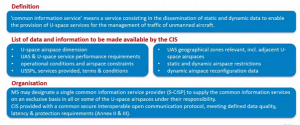
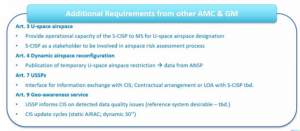
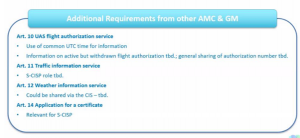
- Traffic information service
The AMC addresses the following aspects:
- Adherence to a common secure open traffic information protocol.
- Informing the operation when there is a degradation of service
- Identifying in real-time when traffic is in proximity
- Report to UAS operator without undue delay
- During flights, remote pilots have to maintain constant watch for traffic information, assess traffic situation, decide whether ops pose any risk and if so discontinue flight
The remote pilot should be aware of all others U-space users in proximity and make constant risk assessments.
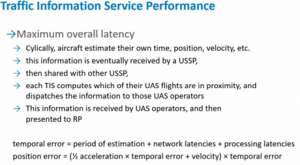
e-Conspicuity
Three standards are conspicuity/communications will be considered:
- ADS-B Out – This is the only technology that is deployed across Europe, which could be used to ensure harmonisation. However, all Member States must accept it to be used for this purpose.
- ADS-L (SRD) – A solution for those users that have already invested in this technology but must able to be adapted in a way that it can be decoded and interpreted easily by USSPs.
- ADSl Mobile – the first non-aviation technology considered for this role.
EASA has commissioned a study to understand whether existing telephone technology as it is today can work to make aircraft conspicuous. From the work so far the answer is “yes…but”. Legal certainty for aerial use needs to be obtained; standardization of frequencies, services and roaming needs to be assured and dedicated devices, rather than smart phones, need to be developed.
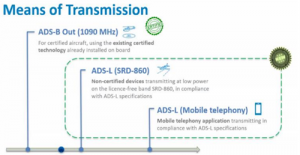
- Coordination with local authorities
Under the new EASA policy Member States will have to designate a new mechanism for coordinating the implementation of U-space management to take account of European, national and local – including local authority and first responder – stakeholders. The new U-space Coordinator will be responsible for managing the hearing process that informs the U-space risk assessment and submitting initial U-space deployment proposals to the competent authority. For more information:
- Requirements for USSPs
The AMC includes requirements to make service descriptions between USSPs and between USSP and the air traffic service provider (ATSP) to be publicly available and adhere to SWIM SD except for some ATM Information Reference Model requirements.
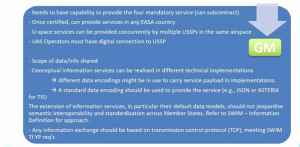
- UAS operators
This is only relevant to this work if UAS operators are acting as an USSP. The UAS must be able to maintain the performance levels needed to last the entire flight, and the USSP is responsible for measuring this capability from the moment of the UAS request. A level of performance must be deemed adequate for the entire flight.
| The aims and objectives of the workshop
The aim of the day-long workshop was to give EASA’s views, having taken account of industry feedback, on: · The concept of a U-space airspace and its management by the Member States (MSs) in terms of risk assessment and responsibilities; · The dynamic reconfiguration of the U-space airspace, when applied; · The operational functioning of the common information service and the certification process for both the providers of this service and the U-space service providers (USSPs); · The technical specifications and related performance requirements for the different U-space services; · The exchange of all data and available information between the participants of the U-space airspace; · The definition of relevant standard(s) for the connection to the common information service provider(s) to ensure interoperability and uniform implementation across the EU; · Detailed procedures and performance requirements for the flight authorisation services; · The acceptable means for manned aircraft to be conspicuous when entering the U-space airspace in uncontrolled airspace; · The expected coordination with local authorities, the security aspects to be covered in a specific U-space airspace, and the authorities’ oversight programme as well as any other task related to the management of the U-space airspace under their responsibility. Detailed presentations from the event will be published in due on the EASA website:
|
(Image: Shutterstock)




